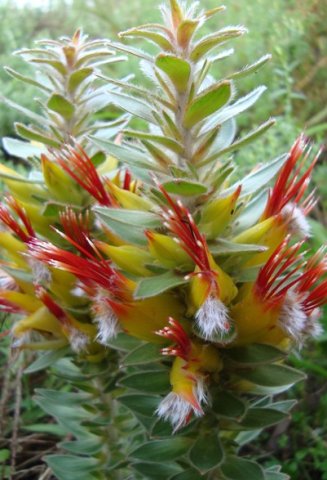Mimetes hirtus flowers

Author: Ivan Lätti
Photographer: Judd Kirkel Welwitch
The flowers of Mimetes hirtus grow in small headlets subtended by leaves near stem-tips. A cluster of stem-tip leaves top the inflorescence. These leaves are up to 14 m long and 9 mm wide. There are from nine to fourteen flowers in each headlet enveloped in yellow involucral bracts with red tips.
The red styles are up to 55 mm long, tapering to their tips and with a white part at the pollen presenter below the purple tip. In picture the white remains from discarded perianth segments hang like beard below the rest of the flowers.
The plants are dependent on sunbirds for pollination and on ants for underground seed dispersal and storage. Every seed has a fleshy attachment, an elaiosome eaten by the ants without damaging the seed’s capacity for propagating the plant. The ants carry the seeds into their nests for use of the elaiosome, giving the seed a chance of surviving the fires that form a normal part of fynbos life. Seeds are released some months after the flowering season. And the ants may carry the used seeds out of the nest again after the edible parts have been consumed (Manning, 2009; Rebelo, 1995; iNaturalist; https://pza.sanbi.org).

